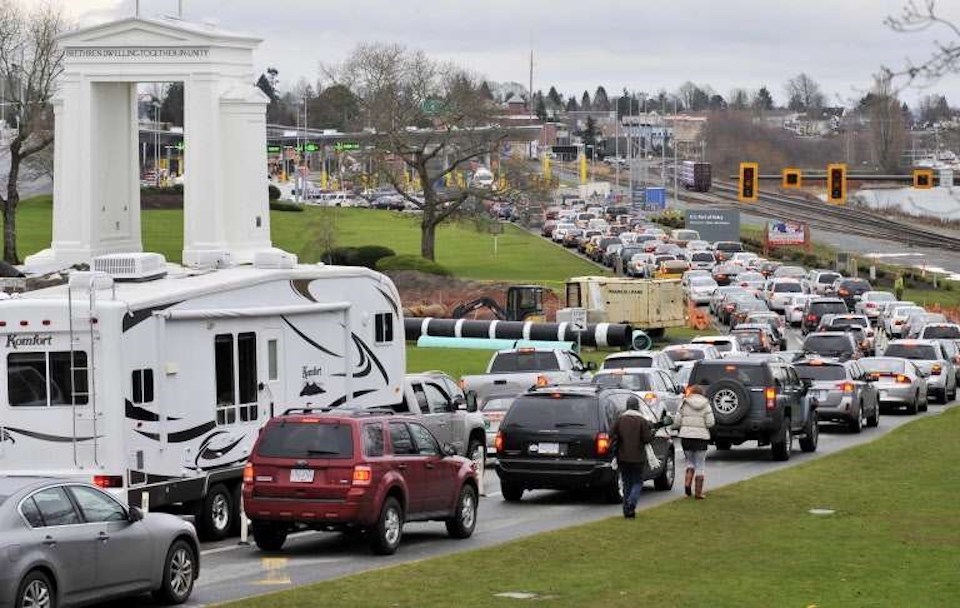Two days before temporarily hitting the pause button on 25 per cent tariffs on Canadian imports, United States President Donald Trump cited criminal activity in British Columbia as justification for his extraordinary trade policy.
Trump’s executive order evoked the flow of fentanyl from Canada and particularly British Columbia under the pretext of a national health emergency, citing the International Emergency Economic Powers Act — which provides a workaround of free trade agreements.
And Trump did so despite comparatively little fentanyl actually being seized at the B.C. border, according to American officials.
“With respect to smuggling of illicit drugs across our northern border, Canada’s Financial Transactions and Reports Analysis Centre (Fintrac) recently published a study on the laundering of proceeds of illicit synthetic opioids, which recognized Canada’s heightened domestic production of fentanyl, largely from British Columbia, and its growing footprint within international narcotics distribution,” Trump’s executive order stated.
The order referred to the Jan. 23 Fintrac operational alert report titled “Laundering the proceeds of illicit synthetic opioids.”
The report states that “according to Canadian law enforcement officials, several domestic groups are suspected of playing an increasing role in the fentanyl market in Canada, with the majority operating in British Columbia as producers and distributors and with the majority of fentanyl precursor shipments being destined for that province.”
And, the report states, “point-of-sale and automated teller machine transactions provided geographic indications that opioids primarily move inland from distribution hubs in Vancouver, British Columbia. From Vancouver, supplies are distributed to Calgary or Edmonton and then to Saskatchewan.”
And, said Fintrac, suspicious transaction reports are finding China as “the primary country used by actors based in Canada for sourcing precursor chemicals and lab equipment, such as industrial pumps and pill presses.”
Trump also proposes to slap China with tariffs but only at a 10 per cent rate.
Fintrac does not mention fentanyl being shipped across the U.S. border, however.
And last October, prior to Trump’s election victory, federal RCMP in B.C. announced the bust of what it called “most sophisticated drug superlab in Canada.”
But police stated the drugs being produced were destined for overseas markets and not the United States.
So how much fentanyl is seized from B.C., according to U.S. Customs and Border Patrol (CBP)?
A relatively infinitesimal amount.
CBP reported in 2023 it seized more than 27,000 pounds of fentanyl making its way into the U.S. Of that, just two pounds was seized crossing from Canada. And of that, just one pound made its way across from B.C., or more specifically the Blaine and Spokane sectors of CBP.
By comparison, CBP seized 26,700 pounds along the southwest border of Mexico and 303 pounds in the “coastal/interior” region.
In 2024, CBP seized 21,900 pounds of fentanyl with only 43 pounds coming from the Canadian border and 24 pounds coming from the Blaine and Spokane (B.C.) sectors.
On Feb. 3, the U.S. Mission to Canada issued a fact sheet statement that again cited the Fintrac report but only acknowledged with more detail the seizures on the southern border: “Last fiscal year, Customs and Border Protection (CBP) apprehended more than 21,000 pounds of fentanyl at our borders, enough fentanyl to kill more than four billion people. It is estimated that federal officials are only able to seize a fraction of the fentanyl smuggled across the southern border.”
Canada is a member of the Trilateral Fentanyl Committee “to address firearms trafficking associated with illicit drug production and distribution under the auspices of the North American Drug Dialogue,” according to the Privy Council Office on Feb. 9, 2024.
Meanwhile, other factors appear at play for Trump in potentially imposing tariffs, such as a trade imbalance between Canada and the U.S. and Trump’s invitation for Canada to become the 51st American state, a notion roundly dismissed by the vast majority of Canadians (82 per cent according to a Leger poll).
On Feb. 1, Prime Minister Justin Trudeau addressed the country and spoke to Trump administration concerns of the Canadian border: “Our border is already safe and secure, but there’s always, always more work to do. Less than one per cent of fentanyl, less than one per cent of illegal crossings into the United States come from Canada.
“But hearing concerns from both Canadians and Americans, including the American president himself, we’re taking action. We launched a $1.3-billion border plan that is already showing results, because we, too, are devastated by the scourge that is fentanyl, a drug that has torn apart communities and caused so much pain and torment for countless families across Canada, just like in the United States,” added Trudeau.




